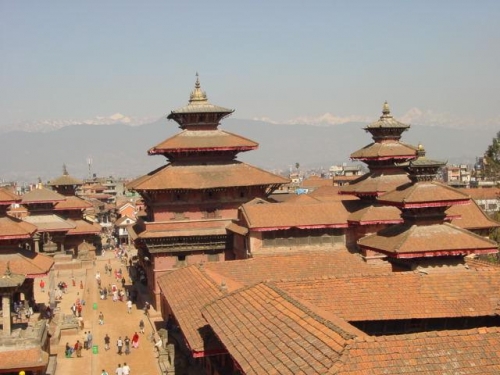Nepal
-8fb20f9be54d6b678adb60fc01965c42.jpg) Legends abound in Kathmandu. From the mythical beginnings of the valley in which, Manjushree, the patron deity of the Kathmandu Valley came upon a lake wherein lay a lotus bloom. Manjushree then struck the southern end of the lake with a sword cleaving the rock and draining the lake to reveal what is today the valley of Kathmandu. The spot where the lotus bloom once stood is marked now by the Stupa of Swoyambhunath, the oldest of its kind in the ..
[Read More]
Legends abound in Kathmandu. From the mythical beginnings of the valley in which, Manjushree, the patron deity of the Kathmandu Valley came upon a lake wherein lay a lotus bloom. Manjushree then struck the southern end of the lake with a sword cleaving the rock and draining the lake to reveal what is today the valley of Kathmandu. The spot where the lotus bloom once stood is marked now by the Stupa of Swoyambhunath, the oldest of its kind in the ..
[Read More]
-37048eed12c7c246b5bc02025996f27f.jpg) As foretold, Manjushree, the patron deity of the Kathmandu Valley came upon a lake wherein lay a lotus bloom. Manjushree then struck the southern end of the lake with a sword cleaving the rock and draining the lake to reveal what is today the valley of Kathmandu. The spot where the lotus bloom once stood is marked now by the Stupa of Swoyambhunath, the oldest of its kind in the world and a UNESCO designated World Heritage Site.This short tour involves ..
[Read More]
As foretold, Manjushree, the patron deity of the Kathmandu Valley came upon a lake wherein lay a lotus bloom. Manjushree then struck the southern end of the lake with a sword cleaving the rock and draining the lake to reveal what is today the valley of Kathmandu. The spot where the lotus bloom once stood is marked now by the Stupa of Swoyambhunath, the oldest of its kind in the world and a UNESCO designated World Heritage Site.This short tour involves ..
[Read More]
-7acef64b4d7e2286bb6d9730cebabae0.jpg) Legends abound in Kathmandu. From the mythical beginnings of the valley in which, Manjushree, the patron deity of the Kathmandu Valley came upon a lake wherein lay a lotus bloom. Manjushree then struck the southern end of the lake with a sword cleaving the rock and draining the lake to reveal what is today the valley of Kathmandu. The spot where the lotus bloom once stood is marked now by the Stupa of Swoyambhunath, the oldest of its kind in the ..
[Read More]
Legends abound in Kathmandu. From the mythical beginnings of the valley in which, Manjushree, the patron deity of the Kathmandu Valley came upon a lake wherein lay a lotus bloom. Manjushree then struck the southern end of the lake with a sword cleaving the rock and draining the lake to reveal what is today the valley of Kathmandu. The spot where the lotus bloom once stood is marked now by the Stupa of Swoyambhunath, the oldest of its kind in the ..
[Read More]
 Legends abound in Kathmandu. From the mythical beginnings of the valley in which, Manjushree, the patron deity of the Kathmandu Valley came upon a lake wherein lay a lotus bloom. Manjushree then struck the southern end of the lake with a sword cleaving the rock and draining the lake to reveal what is today the valley of Kathmandu. The spot where the lotus bloom once stood is marked now by the Stupa of Swoyambhunath, the oldest of its kind in the ..
[Read More]
Legends abound in Kathmandu. From the mythical beginnings of the valley in which, Manjushree, the patron deity of the Kathmandu Valley came upon a lake wherein lay a lotus bloom. Manjushree then struck the southern end of the lake with a sword cleaving the rock and draining the lake to reveal what is today the valley of Kathmandu. The spot where the lotus bloom once stood is marked now by the Stupa of Swoyambhunath, the oldest of its kind in the ..
[Read More]
-0646d44513559c59c344c2213e7828aa.jpg) This tour involves three half day sightseeing tours in Kathmandu and Pokhara and one and half days of activities in Chitwan. The tour will take you through the Kathmandu Durbar Square – whose temples are some of the finest specimen of Nepalese architecture and the Patan Durbar Square – noteworthy for its fine art and craft in addition to traditional Newari building styles. In addition the tour will also take you to the Pashupatinath Temple – one of the holiest Hindu ..
[Read More]
This tour involves three half day sightseeing tours in Kathmandu and Pokhara and one and half days of activities in Chitwan. The tour will take you through the Kathmandu Durbar Square – whose temples are some of the finest specimen of Nepalese architecture and the Patan Durbar Square – noteworthy for its fine art and craft in addition to traditional Newari building styles. In addition the tour will also take you to the Pashupatinath Temple – one of the holiest Hindu ..
[Read More]
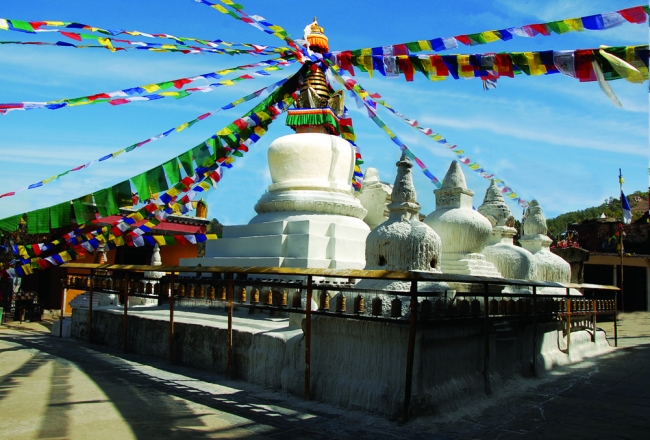 Some 2500 hundred years ago a young prince of the Shakya clan, perturbed by the sufferings of this world, left his clan, family, titles and other worldly possessions and headed off to find the answers that would bring peace and harmony to the world and the individual lives of its inhabitants. He would find the answer while meditating under a Bodhi tree in Gaya of India and be proclaimed the Buddha and set in motion the birth of a new religion ..
[Read More]
Some 2500 hundred years ago a young prince of the Shakya clan, perturbed by the sufferings of this world, left his clan, family, titles and other worldly possessions and headed off to find the answers that would bring peace and harmony to the world and the individual lives of its inhabitants. He would find the answer while meditating under a Bodhi tree in Gaya of India and be proclaimed the Buddha and set in motion the birth of a new religion ..
[Read More]
 The "Bhote Kosi", in Nepali, literally means “Tibetan River”. The river rises as a torrential mountain stream in Tibet and is mostly class 6 once it enters Nepal. However, it becomes quite placid in reaches between Khadichour and Sukute and is a fun river with enough excitement for the whole family. Lots of easy stretches, with blue water, plenty of white sandy beaches and some class 2 rapids to get the adrenaline flowing, just so.Following two days of sightseeing in Kathmandu, ..
[Read More]
The "Bhote Kosi", in Nepali, literally means “Tibetan River”. The river rises as a torrential mountain stream in Tibet and is mostly class 6 once it enters Nepal. However, it becomes quite placid in reaches between Khadichour and Sukute and is a fun river with enough excitement for the whole family. Lots of easy stretches, with blue water, plenty of white sandy beaches and some class 2 rapids to get the adrenaline flowing, just so.Following two days of sightseeing in Kathmandu, ..
[Read More]
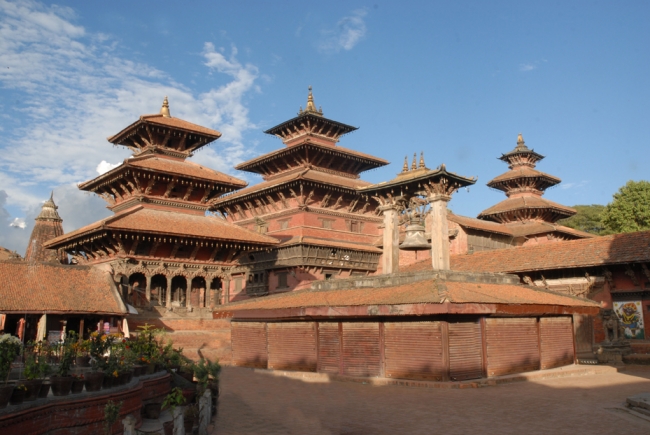 The hills of Nepal offer some of the best hiking and trekking in the world. In fact, organized trekking for tour groups was invented in Nepal. However, not many have the time or energy required for a multi-day trek in Nepal, which often involves flights to remote mountain airstrips that are subject to the whims of Mother Nature. This short hiking trip has been designed to give you a taste of “bigger” things that are possible, but at the same time ..
[Read More]
The hills of Nepal offer some of the best hiking and trekking in the world. In fact, organized trekking for tour groups was invented in Nepal. However, not many have the time or energy required for a multi-day trek in Nepal, which often involves flights to remote mountain airstrips that are subject to the whims of Mother Nature. This short hiking trip has been designed to give you a taste of “bigger” things that are possible, but at the same time ..
[Read More]
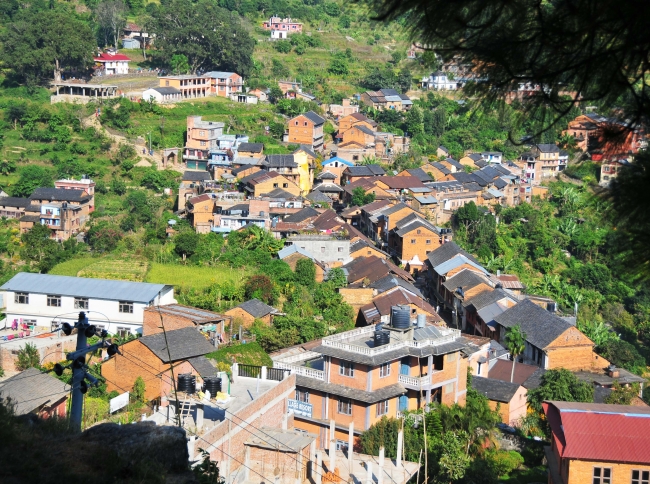 This short, but scenic trip involves both driving and hiking. However, all overnight stays are at the best available accommodations allowing you to recuperate from the day"s activities and to get you ready for additional adventure that will come your way. Bandipur is a quaint little town that used to lie on one of the trading routes to Tibet from the plains and and retains its very old world charm and cultural uniqueness. The Begnas is an artificial lake close to ..
[Read More]
This short, but scenic trip involves both driving and hiking. However, all overnight stays are at the best available accommodations allowing you to recuperate from the day"s activities and to get you ready for additional adventure that will come your way. Bandipur is a quaint little town that used to lie on one of the trading routes to Tibet from the plains and and retains its very old world charm and cultural uniqueness. The Begnas is an artificial lake close to ..
[Read More]
 Officially opened to trekkers in 1990 and just as suddenly forbidden again, the region around Mt Manaslu, the eighth highest mountain in the world at 8163 m was finally "re-opened" in 1992. This trek offers much more than mountains. Starting in the lush green lower hills, inhabited by Indo-Aryan Hindus you will pass through the middle hills, inhabited by the Tibeto-Burmese Magar, Rai, Limbu and Tamang peoples who follow both Hinduism and Buddhism and sometimes Shamanism, to emerge into the high, ..
[Read More]
Officially opened to trekkers in 1990 and just as suddenly forbidden again, the region around Mt Manaslu, the eighth highest mountain in the world at 8163 m was finally "re-opened" in 1992. This trek offers much more than mountains. Starting in the lush green lower hills, inhabited by Indo-Aryan Hindus you will pass through the middle hills, inhabited by the Tibeto-Burmese Magar, Rai, Limbu and Tamang peoples who follow both Hinduism and Buddhism and sometimes Shamanism, to emerge into the high, ..
[Read More]
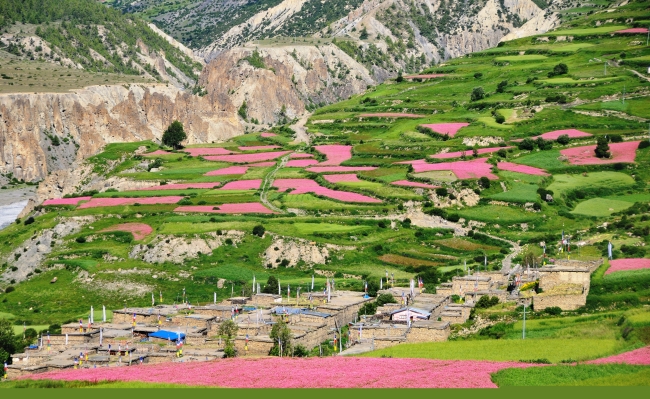 The Annapurna region of Nepal contains some of the greatest trekking trails in the world; none more so than the Annapurna Circuit or the “Around Annapurna” trek which has often been called “the greatest walk in the world.” Many of the people who enjoyed the beauty of the Annapurna circuit originally started their trek in Dumre on the highway from Kathmandu to Pokhara and then walked through the lowland Brahmin and Chettri villages, sub-tropical forests and then higher to emerge at ..
[Read More]
The Annapurna region of Nepal contains some of the greatest trekking trails in the world; none more so than the Annapurna Circuit or the “Around Annapurna” trek which has often been called “the greatest walk in the world.” Many of the people who enjoyed the beauty of the Annapurna circuit originally started their trek in Dumre on the highway from Kathmandu to Pokhara and then walked through the lowland Brahmin and Chettri villages, sub-tropical forests and then higher to emerge at ..
[Read More]
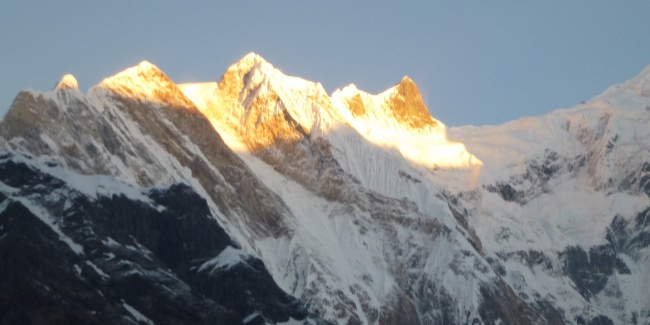 "Annapurna Deothali" as the place is known to the Nepalese is considered sacred, though there is no documentation to show how long this state of affairs has prevailed. It is, however, certain that it was so, long before the first trekkers appeared. The Annapurna Sanctuary forms a natural amphitheater, ringed by Annapurna South 7219 m., Annapurna I 8091 m., Varahashikhar 7847 m., Gangapurna 7485 m., Machhapuchhare or "Fish Tail" as it is commonly known at 6993 m and Hiunchuli 6441 m.The ..
[Read More]
"Annapurna Deothali" as the place is known to the Nepalese is considered sacred, though there is no documentation to show how long this state of affairs has prevailed. It is, however, certain that it was so, long before the first trekkers appeared. The Annapurna Sanctuary forms a natural amphitheater, ringed by Annapurna South 7219 m., Annapurna I 8091 m., Varahashikhar 7847 m., Gangapurna 7485 m., Machhapuchhare or "Fish Tail" as it is commonly known at 6993 m and Hiunchuli 6441 m.The ..
[Read More]
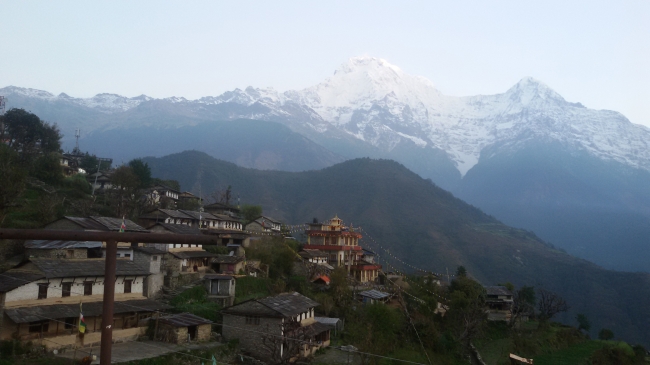 Probably the best two week trek anywhere! The area north of Pokhara no doubt offers up some of the best trekking in terms of mountain scenery, accessibility, neat villages and friendly locals. However, it is also the most trekked part of Nepal. Not this trail though! Diverging from the trail well-travelled this trek passes through oak and rhododendron forests to climb the ridge at Kopra for spectacular unadulterated views of Annapurna South (7219 m.) to the south, Nilgiri (7061 m.), Annapurna ..
[Read More]
Probably the best two week trek anywhere! The area north of Pokhara no doubt offers up some of the best trekking in terms of mountain scenery, accessibility, neat villages and friendly locals. However, it is also the most trekked part of Nepal. Not this trail though! Diverging from the trail well-travelled this trek passes through oak and rhododendron forests to climb the ridge at Kopra for spectacular unadulterated views of Annapurna South (7219 m.) to the south, Nilgiri (7061 m.), Annapurna ..
[Read More]
 Our shortest trek in the Annapurna region. This trek is designed for those who have little time or want to get in a Himalayan trek during a short vacation or even those who want to bring the children along and begin to share the joys of walking in the mountains with them. This trek stays off the beaten track for most of initial days till you get to Poon Hill (3210 m.) via Teen Pokhari or Jaljale, Phulbari (Nepali for ‘flower ..
[Read More]
Our shortest trek in the Annapurna region. This trek is designed for those who have little time or want to get in a Himalayan trek during a short vacation or even those who want to bring the children along and begin to share the joys of walking in the mountains with them. This trek stays off the beaten track for most of initial days till you get to Poon Hill (3210 m.) via Teen Pokhari or Jaljale, Phulbari (Nepali for ‘flower ..
[Read More]
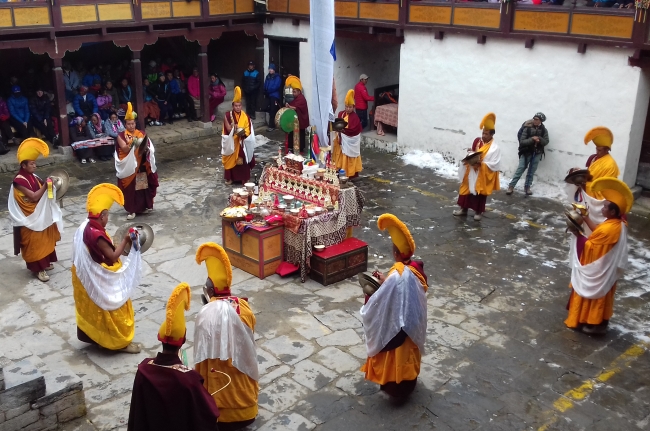 This special 19 days trek has been designed to take you around some of the highest mountains and some of the most holy Tibetan Buddhist monasteries in the world. The trek starts with a flight to Phaplu and passes through beautiful Sherpa villages of Junbesi, Namche, Thame, Khunde and Khumjung to Thyangboche in the lap of the highest mountains on earth. However, the trip is not only about mountains. In its spiritual aspect it will visit the most important Tibetan Buddhist ..
[Read More]
This special 19 days trek has been designed to take you around some of the highest mountains and some of the most holy Tibetan Buddhist monasteries in the world. The trek starts with a flight to Phaplu and passes through beautiful Sherpa villages of Junbesi, Namche, Thame, Khunde and Khumjung to Thyangboche in the lap of the highest mountains on earth. However, the trip is not only about mountains. In its spiritual aspect it will visit the most important Tibetan Buddhist ..
[Read More]
 Many of the great expedition trekking trails have been taken over by lodge operators who have, unfortunately also taken out the romance associated with expedition style treks. The line of porters preceding a trekking party says something about logistical management efficiencies in the high Himalaya, the rows of tents set up awaiting trekkers at a camp site with its dining and kitchen tents, and toilet tents – separate for ladies and gents if the group is large enough, trekkers partaking breakfast ..
[Read More]
Many of the great expedition trekking trails have been taken over by lodge operators who have, unfortunately also taken out the romance associated with expedition style treks. The line of porters preceding a trekking party says something about logistical management efficiencies in the high Himalaya, the rows of tents set up awaiting trekkers at a camp site with its dining and kitchen tents, and toilet tents – separate for ladies and gents if the group is large enough, trekkers partaking breakfast ..
[Read More]
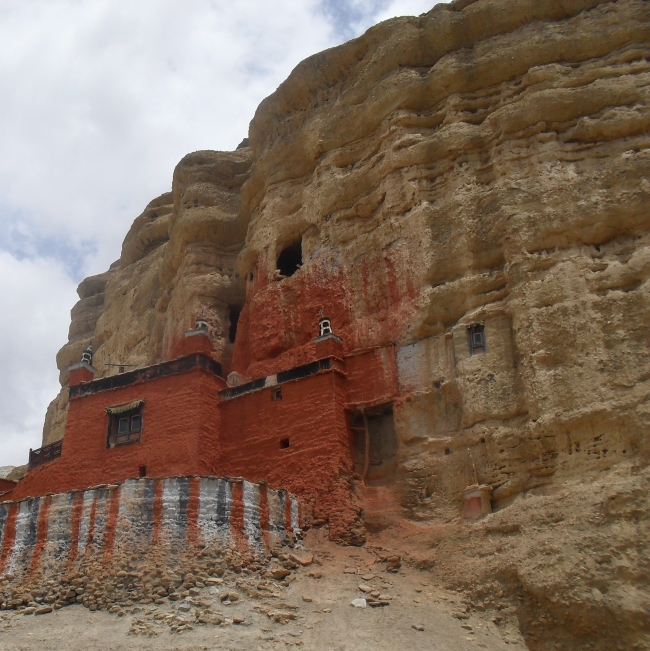 The land of "Lo". Remote and forbidden to travellers for centuries has now been open to trekkers for some time. Your journey begins with a late afternoon flight to Pokhara followed, the next morning, by a flight to Jomosom. From here the trail leads along the left bank of the Kali Gandaki river through the villages of Kagbeni, Chusang, Samochin and Charang to the walled capital of Mustang - Lomanthan. The return is mostly via the same route, except for the ..
[Read More]
The land of "Lo". Remote and forbidden to travellers for centuries has now been open to trekkers for some time. Your journey begins with a late afternoon flight to Pokhara followed, the next morning, by a flight to Jomosom. From here the trail leads along the left bank of the Kali Gandaki river through the villages of Kagbeni, Chusang, Samochin and Charang to the walled capital of Mustang - Lomanthan. The return is mostly via the same route, except for the ..
[Read More]
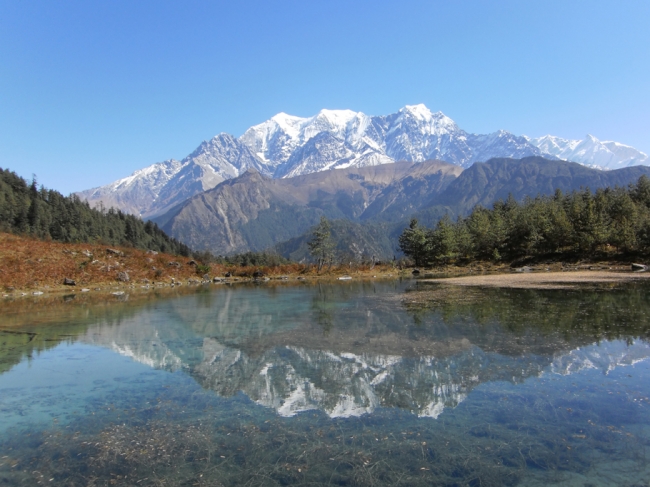 One of the remaining truly remote treks it goes behind the massif of Mt. Dhaulagiri (8167 m.), and the seventh highest mountain in the world into remote areas rarely visited by anyone. Fly form Kathmandu to Pokhara and drive to Beni and then trek up the Myagdi Khola (river) valley to the Italian Base Camp (so named because the first Italian expedition to Dhaulagiri used this site for their base camp) and then traverse the "French Col” or Hidden Valley (where ..
[Read More]
One of the remaining truly remote treks it goes behind the massif of Mt. Dhaulagiri (8167 m.), and the seventh highest mountain in the world into remote areas rarely visited by anyone. Fly form Kathmandu to Pokhara and drive to Beni and then trek up the Myagdi Khola (river) valley to the Italian Base Camp (so named because the first Italian expedition to Dhaulagiri used this site for their base camp) and then traverse the "French Col” or Hidden Valley (where ..
[Read More]
 In 2009 we ran a very special trip for a client whom we may not name to search for the fabled Yeti! Yes, we actually went looking for the Yeti and by all accounts almost found one. But that is a story for another day and another camp fire. After years of waiting we now have permission to bring you that fabled itinerary and take you into the area to see for yourself and perhaps come face to face with the ..
[Read More]
In 2009 we ran a very special trip for a client whom we may not name to search for the fabled Yeti! Yes, we actually went looking for the Yeti and by all accounts almost found one. But that is a story for another day and another camp fire. After years of waiting we now have permission to bring you that fabled itinerary and take you into the area to see for yourself and perhaps come face to face with the ..
[Read More]
 This is the absolutely shortest trip we recommend anyone to take in the Khumbu region, home to Mt. Everest and the hardy Sherpa people of Nepal. If you cannot afford the 8 days round trip from Kathmandu demanded by this trip, go on another trip and come back to the Khumbu region another time! Fly to Lukla from Kathmandu (see previous trip description) and trek through the Sherpa villages of Namche, Thyangboche and Pangboche to Dingboche at the junction of the ..
[Read More]
This is the absolutely shortest trip we recommend anyone to take in the Khumbu region, home to Mt. Everest and the hardy Sherpa people of Nepal. If you cannot afford the 8 days round trip from Kathmandu demanded by this trip, go on another trip and come back to the Khumbu region another time! Fly to Lukla from Kathmandu (see previous trip description) and trek through the Sherpa villages of Namche, Thyangboche and Pangboche to Dingboche at the junction of the ..
[Read More]
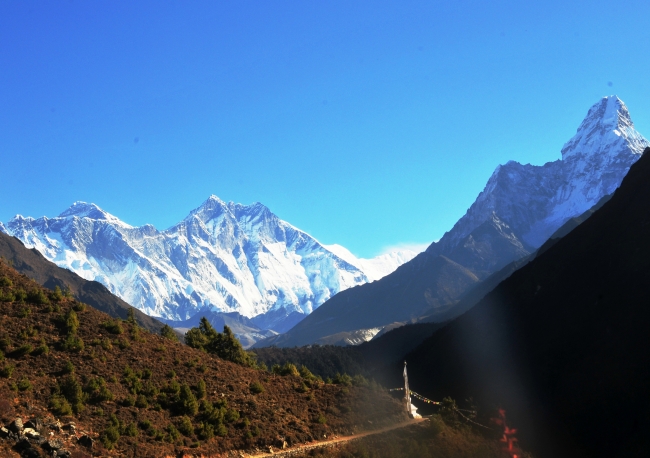 The very words Mt. Everest evoke visions of heroism, glory and man"s relentless need to pit his mind and body against the best that mother nature has to offer. At 8850 meters Mt. Everest is the highest point on earth and has been a magnet for adventurers seeking glory in its conquest. However, not everyone is inclined to glory and conquest. Some of us just want to get in close and enjoy the bounties that nature has bestowed on this earth ..
[Read More]
The very words Mt. Everest evoke visions of heroism, glory and man"s relentless need to pit his mind and body against the best that mother nature has to offer. At 8850 meters Mt. Everest is the highest point on earth and has been a magnet for adventurers seeking glory in its conquest. However, not everyone is inclined to glory and conquest. Some of us just want to get in close and enjoy the bounties that nature has bestowed on this earth ..
[Read More]
 This is "the grand tour" of the Dudh Kosi river valley, the Khumbu valley and the Imja river valley. This strenuous trek starts with that still “eye opening flight” into Lukla – a 450 meter long airstrip with a 60 m elevation difference between the two ends of the runway! Trek through the villages of Namche, Thame, Khumjung/Khunde to Phortse, Then trek up the Dudh Kosi river valley to the Gokyo Lake at the bottom of the Ngozumba glacier. Cross over ..
[Read More]
This is "the grand tour" of the Dudh Kosi river valley, the Khumbu valley and the Imja river valley. This strenuous trek starts with that still “eye opening flight” into Lukla – a 450 meter long airstrip with a 60 m elevation difference between the two ends of the runway! Trek through the villages of Namche, Thame, Khumjung/Khunde to Phortse, Then trek up the Dudh Kosi river valley to the Gokyo Lake at the bottom of the Ngozumba glacier. Cross over ..
[Read More]
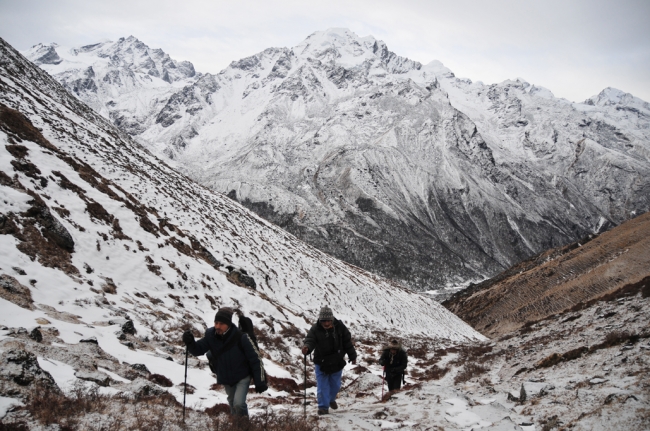 Considering its proximity to Kathmandu, stark Himalayan views, densely wooded areas harboring a wealth of flora and fauna and connection by road – no need to rely on small Short Take Off and Landing aircraft that fly to postage stamp size airfields in the far flung remote area of Nepal, it is a surprisingly little traveled area and offers great mountain scenery and cultural exposure.The Langtang National Park is situated due north northwest of Kathmandu and is the home to about ..
[Read More]
Considering its proximity to Kathmandu, stark Himalayan views, densely wooded areas harboring a wealth of flora and fauna and connection by road – no need to rely on small Short Take Off and Landing aircraft that fly to postage stamp size airfields in the far flung remote area of Nepal, it is a surprisingly little traveled area and offers great mountain scenery and cultural exposure.The Langtang National Park is situated due north northwest of Kathmandu and is the home to about ..
[Read More]
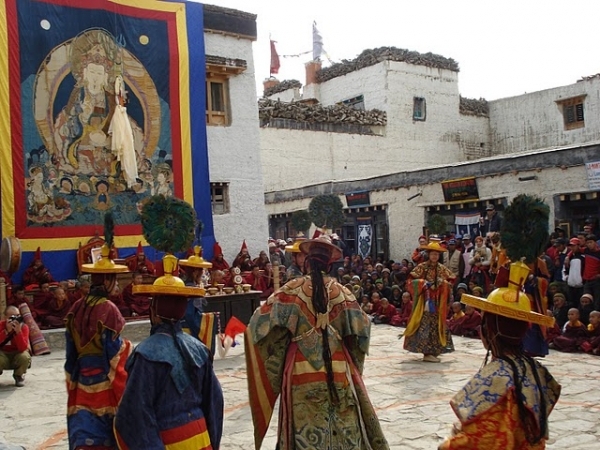 The Tiji festival is held in Lo Manthang every year and is a three-day ritual known as "The chasing of the Demons" that focuses on the Tiji myth. The myth tells of a deity named DorjeJono who must battle against his demon father to save the Kingdom of Mustang from destruction. The demon father wreaked havoc on Mustang by bringing a shortage of water (a highly precious resource in this very dry land) causing many resultant disasters from famine to animal ..
[Read More]
The Tiji festival is held in Lo Manthang every year and is a three-day ritual known as "The chasing of the Demons" that focuses on the Tiji myth. The myth tells of a deity named DorjeJono who must battle against his demon father to save the Kingdom of Mustang from destruction. The demon father wreaked havoc on Mustang by bringing a shortage of water (a highly precious resource in this very dry land) causing many resultant disasters from famine to animal ..
[Read More]
 A rite of passage in every Hindu man’s life is the donning of the “sacred thread” or “Janai” in Nepali. Once donned, the Hindu in question will be regarded as having achieved majority and assumes his place within his caste, empowered to carry out religious rituals, marry, mourn the passing of a family member, etc. Every year, on the full moon “Purnima”, falling within the fourth month of the Hindu lunar calendar the thread must be ritually changed. Apart from the ..
[Read More]
A rite of passage in every Hindu man’s life is the donning of the “sacred thread” or “Janai” in Nepali. Once donned, the Hindu in question will be regarded as having achieved majority and assumes his place within his caste, empowered to carry out religious rituals, marry, mourn the passing of a family member, etc. Every year, on the full moon “Purnima”, falling within the fourth month of the Hindu lunar calendar the thread must be ritually changed. Apart from the ..
[Read More]








